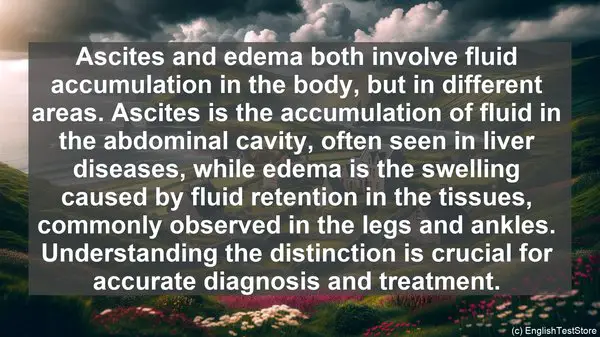Introduction
Welcome to today’s lesson on hepatology. In this lesson, we will be discussing the top 10 commonly confused words in this field. Understanding these words correctly is crucial for accurate communication and interpretation of medical information. So, let’s dive in!
1. Hepatitis vs. Cirrhosis
The terms ‘hepatitis’ and ‘cirrhosis’ are often used interchangeably, but they refer to different conditions. Hepatitis is the inflammation of the liver, usually caused by a viral infection, while cirrhosis is the scarring of the liver due to long-term damage. While both can have similar symptoms, their causes and treatments differ significantly.

2. Ascites vs. Edema
Ascites and edema both involve fluid accumulation in the body, but in different areas. Ascites is the accumulation of fluid in the abdominal cavity, often seen in liver diseases, while edema is the swelling caused by fluid retention in the tissues, commonly observed in the legs and ankles. Understanding the distinction is crucial for accurate diagnosis and treatment.
3. Jaundice vs. Icterus
Jaundice and icterus are two terms used to describe the yellowing of the skin and eyes. While they are often used interchangeably, ‘jaundice’ is the more general term, while ‘icterus’ specifically refers to the yellowing caused by excess bilirubin in the blood. Both can be indicative of liver dysfunction, but the underlying causes may vary.
4. Hepatomegaly vs. Splenomegaly
Hepatomegaly and splenomegaly both refer to organ enlargement, but in different organs. Hepatomegaly is the enlargement of the liver, often seen in liver diseases, while splenomegaly is the enlargement of the spleen, which can be due to various causes. Accurately identifying the organ involved is crucial for appropriate management.
5. Cholestasis vs. Cholelithiasis
Cholestasis and cholelithiasis are two terms related to the bile system. Cholestasis refers to the reduction or blockage of bile flow from the liver, while cholelithiasis is the formation of gallstones in the gallbladder. While they can coexist, they are distinct conditions with different implications and management strategies.
6. Fibrosis vs. Cirrhosis
Fibrosis and cirrhosis both involve scarring of the liver, but they represent different stages of the same process. Fibrosis is the initial stage, where there is excessive deposition of connective tissue, while cirrhosis is the advanced stage, characterized by extensive scarring and irreversible damage. Timely identification of fibrosis can help prevent its progression to cirrhosis.
7. Hepatocellular Carcinoma vs. Metastatic Liver Cancer
Hepatocellular carcinoma and metastatic liver cancer are two types of liver cancer, but with different origins. Hepatocellular carcinoma originates in the liver cells, while metastatic liver cancer is the spread of cancer from other organs to the liver. The treatment approaches and prognosis can vary significantly based on the type.
8. Hepatic Encephalopathy vs. Hepatic Coma
Hepatic encephalopathy and hepatic coma are both neurological complications of liver disease, but they represent different degrees of severity. Hepatic encephalopathy refers to the cognitive and motor disturbances, while hepatic coma is the most severe form, characterized by deep unconsciousness. Recognizing the signs and managing them promptly is crucial for patient outcomes.

9. Portal Hypertension vs. Varices
Portal hypertension is the increased blood pressure in the portal vein, often seen in liver diseases. Varices, on the other hand, are the dilated blood vessels that can develop in various organs, commonly the esophagus and stomach, as a result of portal hypertension. Understanding this relationship is vital, as varices can be prone to bleeding and require specific interventions.
10. Hepatorenal Syndrome vs. Acute Kidney Injury
Hepatorenal syndrome and acute kidney injury are two conditions involving kidney dysfunction, but with different underlying mechanisms. Hepatorenal syndrome is a functional renal impairment often seen in advanced liver disease, while acute kidney injury can have various causes, including infections and medications. Accurate diagnosis is essential for appropriate management.
